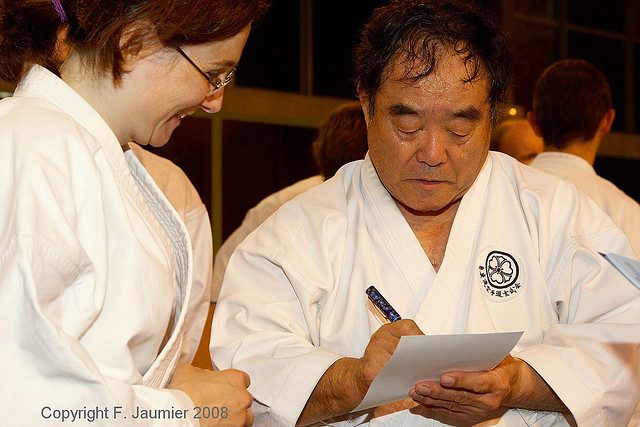What do you know about kata?
“Kata is a set of moves you perform in Karate” most people would say. Or “It’s these self-defense moves you do against imaginary opponents”. But the truth is that kata is not unique to martial arts, like Karate. No, no, no, it’s much more than that.
In fact, in Japan your whole life is governed (restricted?) by all sorts of different kata.
Let me explain:
First of all, kata means form, or shape. Or should I say correct form, or shape. Whenever you do something in your daily life, you must do it the right way. You must follow the kata for how to do it.
For example, you can not eat how you want to. That’s really annoying. When you eat you must follow the tabe-kata – the correct way of eating. Or when you are writing your Japanese characters you must follow the kaki-kata (correct way of writing).
There are dozens of more kata, for example ike-kata (correct way of living), yomi-kata (correct way of reading), shi-kata (correct way of doing something), tsukai-kata (correct way of using something), hanashi-kata (correct way of talking), denwa no uke-kata (correct way of receiving a phonecall), kangae-kata (correct way of thinking), tanomi-kata (correct way of asking/requesting something), kaimono-kata (correct way of shopping) and so on.
Almost everything you do has a kata. In fact, hardly any area of Japanese life isn’t influenced by a kata – a predetermined mechanical process of how something should be done. Stylized, ritualized behaviour, without exceptions.
And Japanese are extremely sensitive to thought, manner or action that doesn’t fit perfectly with the appropriate kata. You probably realize that this inevitably leads to problems for foreigners.
Like me.
When I first came to Okinawa, I didn’t know anything about kata. I knew the kata of Karate, of course, but not the other kata (that I just described above). In other words, I didn’t understand the cultural molds that shape and define Japan. But I learned along the way. Everyone does.
Like this one time when I decided to go out and eat.
I had seen this great little place with all kinds of yummy Okinawan dishes, and had waited a long time to go there. Finally, one day I went. Immediately upon entering the “eating-place” (you can hardly call it a restaurant) I had thirty Okinawans with big eyes staring at me. I felt like a cowboy entering a saloon in the wrong part of town. With a squirt gun instead of a revolver.
This wasn’t a place for outsiders.
I stood in the doorway and scanned the big menu on the wall. Recognizing the sign for “fish” I pointed and said I wanted that. Hoping for the best (but expecting the worst) I made my way through the staring Okinawans to a table.
It was the kind of table where you remove your shoes and sit on the floor. Here we had one kata I didn’t know about – the correct way of removing and placing your shoes. Apparently, you always place your shoes with the toe side pointing away from you. So you can just slide the shoes on easily when you leave.
I did the opposite of course.
An old man sitting next to me noticed it though, and he wasn’t about to let that slide. When he saw that I looked away, with ninja-like quickness he reached for my shoes and turned them, placing them neatly next to the other shoes, the correct way. I felt a little bit offended at first. “What, didn’t I place my shoes good enough for you?” I thought.
But then I realized that his Japanese mind just couldn’t stand seeing something that stuck out. Something that didn’t follow the kata.
It’s like the Japanese saying “Deru kui wa utareru”.
“The nail that sticks up gets hammered down”
My shoes were like a protruding nail that he just had to hammer down. Everyone must follow the kata, to maintain harmony. Even foreigners…
Anyway, after waiting ten minutes or so, my food finally came. It was a tray with several small plates on: fish, rice, vegetables and so on. I placed the tray on the table in front of me, and I could immediately see the eyebrows twitching in the old man beside me. Something was apparently wrong again.
Now guess what he does.
He mumbles something in Japanese, while he reaches for my tray, and then rotates the whole thing! Then he says “The rice must always be on the left side”, and continues eating his own food like nothing ever happened.
“What?!!”
I didn’t know whether to laugh or cry.
But apparently, this is the way of eating correctly. This is the tabe-kata. And “everyone” knows this.
You see, a life without kata is unthinkable for the Japanese. They wouldn’t know how to do, or act, and would probably panic most of the time! Like the old man who corrected my tabe-kata almost did.
In Japan, form (kata) almost has a reality of its own, and often comes before substance. Maybe I’m left-handed, and want my rice on the other side? Nope, that’s not the correct way. That’s not the kata for eating.
In the Western world, were individualism and pragmatism rules, we often say that substance should come before form. We think rituals and stylized behaviour is good as long as it is practical. For instance, compare the American boss who screams “I don’t care how you do it, just get it done!” with the Japanese boss who says “I don’t care what the result is, just do it right!”
Mix that with Karate, and you have an interesting phenomenon…
I’m not going to spell it out for you, think!
Let me end with a quote (as I like to do), by veteran Japanologist Boyé Lafayette De Mente:
“[Modern] Karate is a perfect example of Japanese kata in action in an ideal situation based on total control of the mind and body, absolute adherance to minutely prescribed behaviour, the mastery of techniques designed to mount a perfect defense or demolish an opponent, and a moral philosophy that integrates peace and power.”



10 Comments